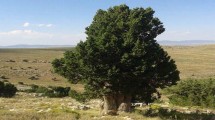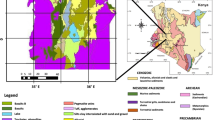Abstract
The concentrations of nine mineral elements were determined by atomic absorption spectroscopy in Gentiana rigescens from three zones (middle, southeast, and northwest zones) of Yunnan province in China. The average concentrations of mineral elements were found in the order K>Ca>Mg>Fe>Na>Zn>Cu>Cr>Se. Samples collected from the middle zone of Yunnan were enriched in Na (242.24 ± 50.80 mg/kg) and Mg (959.78 ± 54.60 mg/kg). However, materials from the southeast zone were particularly enriched in Ca (3,448.70 ± 749.82 mg/kg), but depleted in Se. Whereas those from the northwest zone were plentiful of K (2,746.89 ± 84.84 mg/kg), Fe (923.06 ± 127.52 mg/kg), Zn (261.38 ± 53.05 mg/kg), Cu (110.08 ± 46.23 mg/kg), and Se (53.99 ± 22.38 mg/kg).
Similar content being viewed by others
References
Matsukawa K, Ogata M, Hikage T et al (2006) Antiproliferative activity of root extract from Gentian plant (Gentiana triflora) on cultured and implanted tumor cells. Biosci Biotechnol Biochem 70:1046–1048
The state Pharmacopoeia Commission (2010) Chinese PharmacopodiaI. Medicine Science & Technology Press, Beijing
Yang WX, Zhou L, Geng HL et al (2003) A survey of study of chemical components of medicinal plants of Gentianaceae. Acta Bot Boreal-Occident Sin 23:2235–2240
Xu M, Wang D, Zhang YJ et al (2007) Dammarane triterpenoids from the roots of Gentiana rigescens. J Nat Prod 70:880–883
Tuo F, Li DH, Zhou FQ et al (2010) Determination of trace elements in Chinese medicinal plants by instrumental neutron activation analysis. J Radioanal Nucl Chem 284:507–511
Ražić S, Onjia A, Đogo S et al (2005) Determination of metal content in some herbal drugs-empirical and chemometric approach. Talanta 67:233–239
Nasim SA, Dhir B (2010) Heavy metals alter the potency of medicinal plants. Rev Environ Contam Toxicol 203:139–149
Başgel S, Erdemoğlu SB (2006) Determination of mineral and trace elements in some medicinal herbs and their infusions consumed in Turkey. Sci Total Environ 359:82–89
Singh P, Negi JS, Rawat MSM et al (2010) Quantification of mineral elements of Rheum emodi Wallr. (Polygonaceae). Biol Trace Elem Res 138:293–299
Adnan M, Abdul-Wahab ER, Hala S (2011) Lead, cadmium, copper, zinc, iron, and calcium in human hair as a function of gender, age, smoking, and hair dyeing. Toxicol Environ Chem 93:494–503
Abdul-Wahab ER, Adnan M, Mohammad O (2008) Evaluation of Pb, Cu, Zn, Cd, Ni and Fe levels in Rosmarinus officinalis labaiatae (Rosemary) medicinal plant and soils in selected zones in Jordan. Environ Monit Assess 140:61–68
Watts DL (1997) Trace elements and other essential nutrients: clinical application of tissue mineral analysis. Meltdown International, Nevada
Fortes C, Agabiti N, Fano V et al (1997) Zinc supplementation and plasma lipid peroxides in an elderly population. Eur J Clin Nutr 51:97–101
Allaway WH (1968) Agronomic controls over environmental cycling of trace elements. Adv Agron 20:235–274
Bowen HJM (1966) Trace elements in biochemistry. Academic, New York
Liu R, Ma S (2008) The determination of selenium in WuyiCliff tea. Modem Agric Sci 15:47–49
Ceng T, Wang JC, Chen H (1996) The five elements in serum of patients with cerebral infarction changes. Sci Chin Trace Elem 2:17–18
WHO (2005) Quality control methods for medicinal plant materials. World Health Orgainzation Offset Publication, Geneva
Zeng YW, Wang LX, Pu XY et al (2009) The zonal characterization if elemental concentrations in brown rice of core collection for rice landrace in Yunnan province by ICP-AES. Spectrosc Spect Anal 29:1691–1695
Yu CL (2003) Effects of microelements on the active ingredient nutrient uptake and yield of Gentiana. Northeast Agricultural University, Haerbin
Acknowledgments
This work was supported by National Key Technology R&D Program of China (no. 2011BAI13B02-04), project of Technological Innovation Talent Training of Yunnan Province (no. 2010CI068), Key Technologies R & D Program of Yunnan Province (no. 2010GG026), and Special Research Foundation of Development of Nonpublic Economies of Yunnan Province [no. (2010) 114].
Author information
Authors and Affiliations
Corresponding author
Rights and permissions
About this article
Cite this article
Zhang, J., Yuan, T., Wang, Y. et al. Determination of Mineral Elements in Gentiana rigescens from Different Zones of Yunnan, China. Biol Trace Elem Res 147, 329–333 (2012). https://doi.org/10.1007/s12011-011-9293-5
Received:
Accepted:
Published:
Issue Date:
DOI: https://doi.org/10.1007/s12011-011-9293-5




